
Enterprise-level LMS reporting features and tools are crucial criteria when choosing a learning management system (LMS). The problem for larger teams and organizations, however, is prioritizing which LMS reporting features their chosen system should have to help:
- Maintain compliance in line with security and safety requirements
- Deliver content to diverse audiences with unique training needs
- Present digestible data to key stakeholders
- Monitor the ROI of corporate training
- Measure employee engagement
With so many LMS reporting tools to consider and multiple reporting requirements that are unique to your business, knowing which reports will meet your needs in advance becomes a powerful asset; you’re better equipped to meet compliance requirements, communicate with key stakeholders and optimize corporate training to fuel growth.
In this post, I’ll reveal critical LMS reporting features and tools to consider when choosing an enterprise LMS.
(Skip ahead to a specific reporting feature by clicking the name below.)
- Example: Using LMS Reporting To Fuel Growth
- 9 Learning Management System Reports For Corporate Training & Compliance
- LMS Reporting Feature #1: Mandatory Certification And Compliance Reports
- LMS Reporting Feature #2: Completion Rates And Progress
- LMS Reporting Feature #3: Automated Custom Reports To Non-admins
- LMS Reporting Feature #4: Employee Engagement And Reminders
- LMS Reporting Feature #5: Activity Reports
- LMS Reporting Feature #6: Configurable Search Fields And Filters
- LMS Reporting Feature #7: Graphical Reporting
- LMS Reporting Feature #8: Export, Schedule And Share Report
- LMS Reporting Feature #9: Dashboard Reports And Navigation Shortcuts
Before we dive into any specifics, let’s review a real-world example of how strong LMS reporting features can fuel extended enterprise growth…
Example: Using LMS Reporting To Fuel Growth
With a global reach spanning across 20 countries, Glovo, an app-mediated courier service, has over 3,400 customer service agents spread across 15 different call centers. Demand for their service soared in 2020.
With an extended enterprise workforce of independent contractors acting as the backbone of stakeholder support, Glovo needed to ensure that their agents received up-to-date training relevant to an agent’s country, region or specific support role.
“We were expanding, and we needed to scale our platform.”–Miquel Gomez, Global Training Manager.
Unfortunately, inaccurate and unscalable reporting features in Glovo’s previous LMS thwarted their ability to effectively manage and deliver training for thousands of agents.
Discrepancies were rife in the old learning platform. It failed to accurately communicate essential details (such as how many agents completed tests or viewed important documents).
After switching to Totara Learn’s open-source LMS, however, Glovo used rich audience management and reporting features to measure the effectiveness of their training.
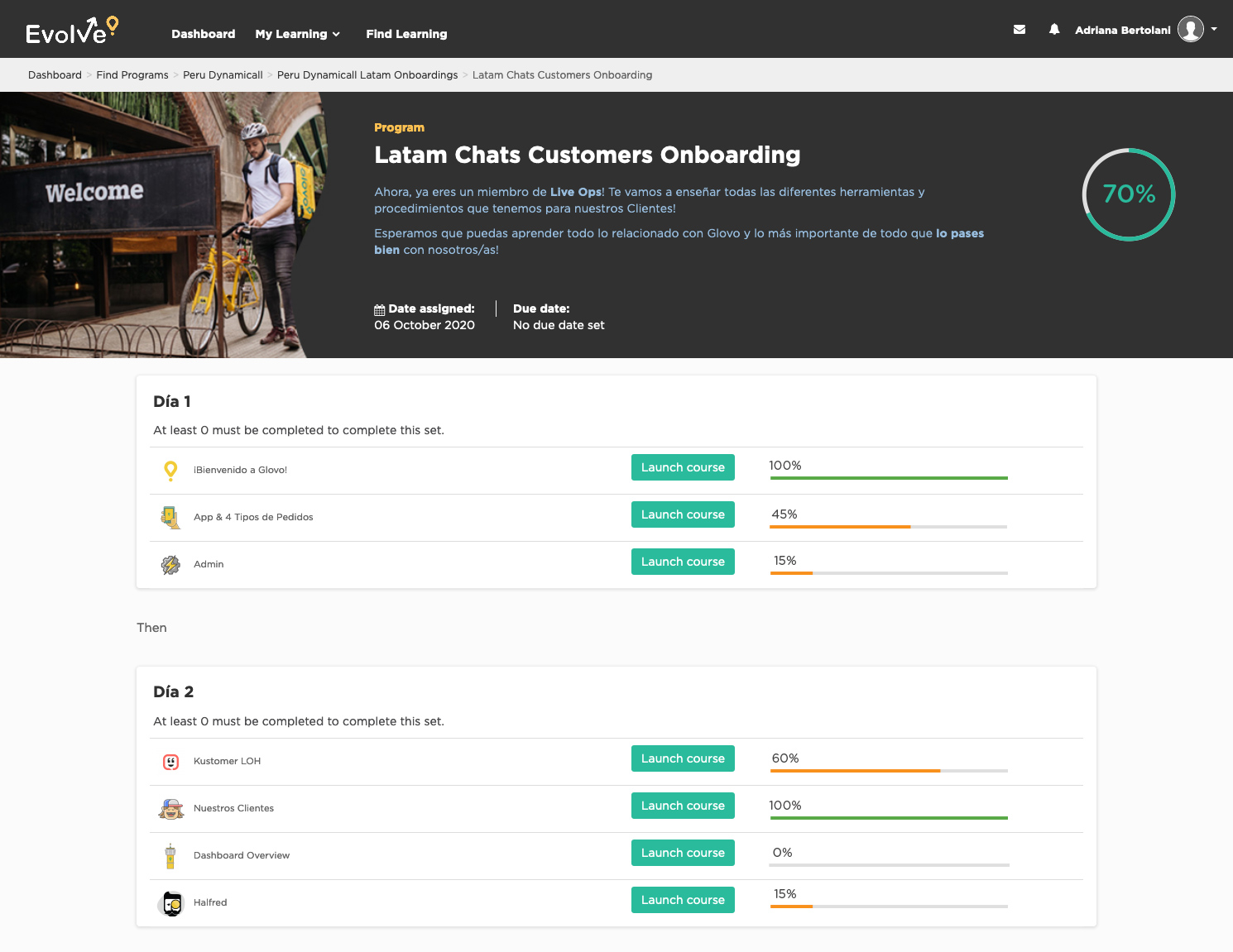
This enabled them to tailor their content to different stakeholders and develop an effective corporate training system (in nine different languages) to onboard and continuously develop an increasingly diverse workforce—all in the throes of a global pandemic.
9 learning management system reports for corporate training & compliance
With an enterprise learning management system like Totara Learn, you have a variety of built-in LMS report templates and the tools to create your own custom reports with the report builder. Ahead, you’ll find a list of the most useful reports for a large organization with complex corporate training and reporting requirements.
LMS reporting feature #1: mandatory certification and compliance reports
Demand for staff training has more than doubled over the past few years within enterprise organizations.
Throw in emergencies or sudden changes to laws, regulations or government policies on top of these already-intense training requirements, and setting aside time to complete training becomes a challenge for both the employee and employer.
Left unchecked, or if employees aren’t prompted, the result is a rise in uncompleted courses that snowball into plummeting compliance rates and, in serious cases, hefty penalties.
This is why compliance reports are critical. In Totara Learn, the Certification Completion Status Overview report helps report compliance.

This report—which can be scheduled at set intervals to be emailed to managers and learning administrators—allows stakeholders to proactively track and manage compliance and other mandatory training while generating evidence of compliance for an individual, team, department or organization.
LMS reporting feature #2: completion rates and progress
When working with mandatory courses designed to meet compliance requirements, delivering effective training to your employees is only the beginning. You’ll want to know how people are interacting with your course, and especially how many people pass it.
This is where the course completion report (one of Totara Learn’s most popular built-in reports) comes in handy.
This report lists all of the users enrolled in a course against the activities required for course completion and the overall course completion status.
To work with completion in more detail—which most large organizations often do—you can use Totara Learn’s completion editor to view and edit completion reports at a granular level.
Watch the video tutorial below to see how Totara Learn’s course completion reports work.
LMS reporting feature #3: automated custom reports to non-admins
When’s the last time your department or organization had to pivot your reporting or corporate training to meet new requirements or regulations?
Under the pressure of meeting new regional compliance regulations regarding security and accessibility, Subaru needed to improve its reporting and corporate training system.
To do this, they turned to Totara Learn’s automated reports.
Thanks to Totara Learn’s enterprise-level reporting features and a product extension, Subaru created a custom report that tracked and showed the total time spent across online and instructor-led courses, thus complying with the Province of Quebec’s new legislation for reporting.
The automated delivery of reports and HTML-embedding also allowed Subaru to easily deliver concise actionable reports to everyone from dealers, field managers and even corporate management.
As Subaru’s story shows, compliance laws and regulatory requirements change. When they do, reporting requirements, which are already quite complex and varied within large organizations, are forced under the microscope.
Different roles and teams can suddenly have new distinct goals, training, regulatory requirements and even methods of performance measurement. This means that a range of non-administrative users—like field managers, instructors and C-suite staff—need to frequently view complex company-wide reports tailored to their priorities and their department’s performance.
In Totara Learn, customizable reporting paired with hierarchy features mean that relevant reports can be created for, and instantaneously accessed by, non-administrative internal and external users.
These reports operate at a site-wide level. Rather than focusing on one specific course, they’re able to capture and reveal critical data needed to measure compliance, competencies and corporate training across an entire organization.
LMS reporting feature #4: employee engagement and reminders
In a large organization, dedicating time to complete mandatory compliance training is a struggle that should be addressed to prevent penalties associated with non-compliance.
This is easily done with an LMS report like the Course Participants reports in Totara Learn. The Course Participants report allows you to measure learner engagement and nudge learners who are falling behind to complete important training tasks.
Here’s an example of how Deloitte Accountancy used this feature to prompt lagging learners and increase completion rates on their soft skills training course, which won a 2020 Totara Award:

LMS reporting feature #5: activity reports
The Activity Report shows when an activity was last accessed and the number of views it generated.
Showing which activities are most – or least – popular, this LMS reporting feature enables you to quickly measure progress, make important decisions and diagnose bottlenecks in your corporate training courses.
In Totara Learn, you can access more data on specific activities because they have their own reporting functions.

If you want to see how many people access a CPR-related or hygiene-related SCORM activity, for example, you can see a series of reports which reveal information on attempts, visual data and more detailed information on how learners interact with elements within the SCORM object, and whether learners have attempted and passed a quiz.
LMS reporting feature #6: configurable search fields and filters
Accessing a report is one thing. Interpreting it, however, is another issue entirely. As mentioned earlier, different stakeholders will want to extrapolate different types of data and insight from any given report.
This is where an LMS with configurable search fields and filters in its reports, (added by an admin Totara Learn), can be useful for browsing and interpreting different types of data.

Content configuration for report settings also allows multiple users to view a single report with filters. This means that multiple stakeholders viewing a single shared report will be shown pre-filtered data and insights which are relevant to them.
LMS reporting feature #7: graphical reporting
Graphical LMS reporting features are extremely valuable for any enterprise organization as they allow stakeholders to pinpoint training-related issues and instantly digest, manipulate and share data.
This makes it easier to increase compliance, manage employee performance and keep all relevant stakeholders in the loop.
In Totara Learn, you can visualize reports in multiple formats. For reference, below are different examples of how a certification completion status report can be converted into a:
Pie chart:
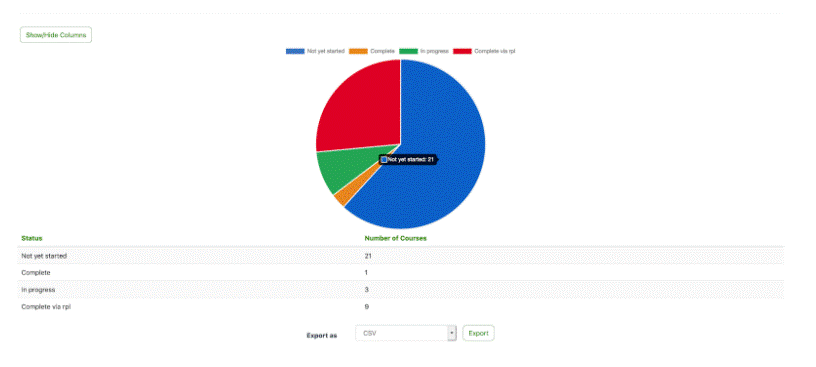
Horizontal bar chart:

Area chart:

Donut chart:
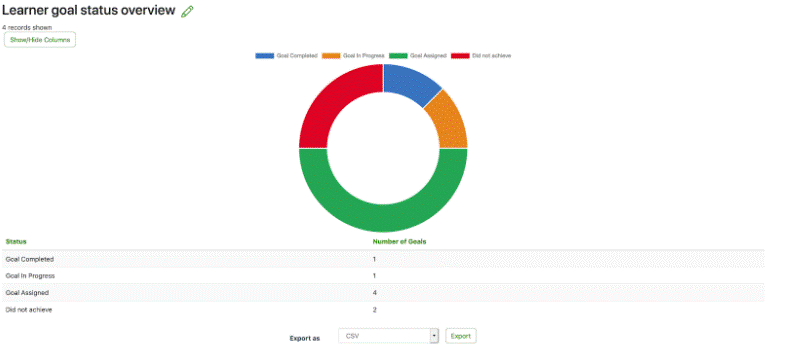
LMS reporting feature #8: export, schedule and share report
Another bunch of smaller, but equally important LMS reporting features for enterprise training include the ability to export, schedule and send reports.
Totara Learn makes all the above simple and efficient. Within a couple of clicks you can export any report as a:
- CSV
- CSV (optimized for Excel)
- Excel sheet
- ODS
- PDF landscape
- PDF portrait
For reports you’d need to run frequently, like monthly completion rates on a critical SCORM (test) activity, simply set the report to run at a specific time or set interval, choose the format you want to receive it in, and schedule it.
Reports can also be scheduled to go out to yourself or others by email.
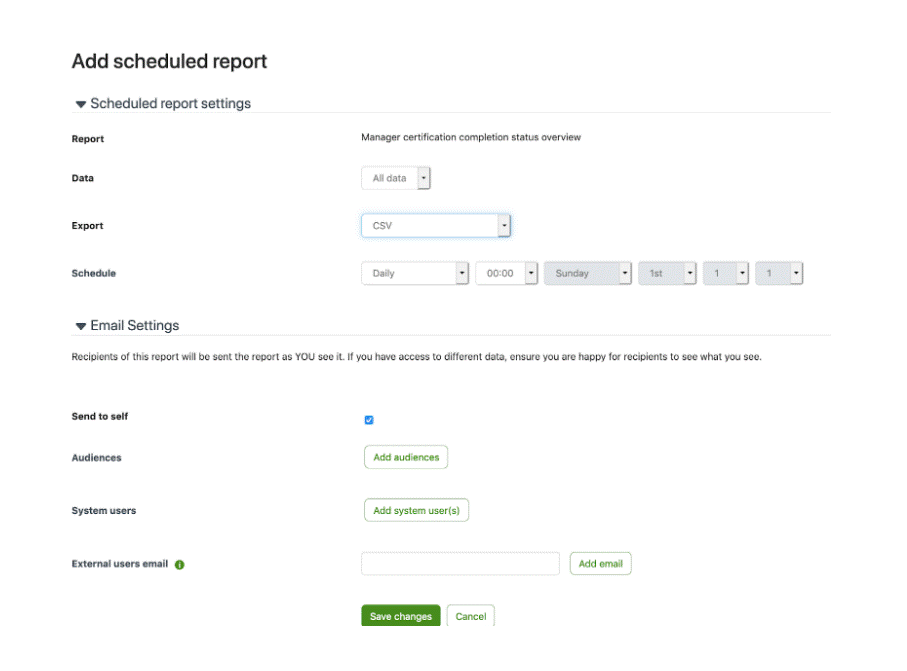
LMS reporting feature #9: dashboard reports and navigation shortcuts
Quickly retrieving data through information-rich reports and graphical charts is great. Creating or even navigating between different reports, however, can prove too technical or time-consuming a task for busy stakeholders.
But what if you could stick the most common and useful reports on a homepage to make them more accessible to relevant users?
Using the report and report graph blocks within dashboards in Totara Learn, you can.
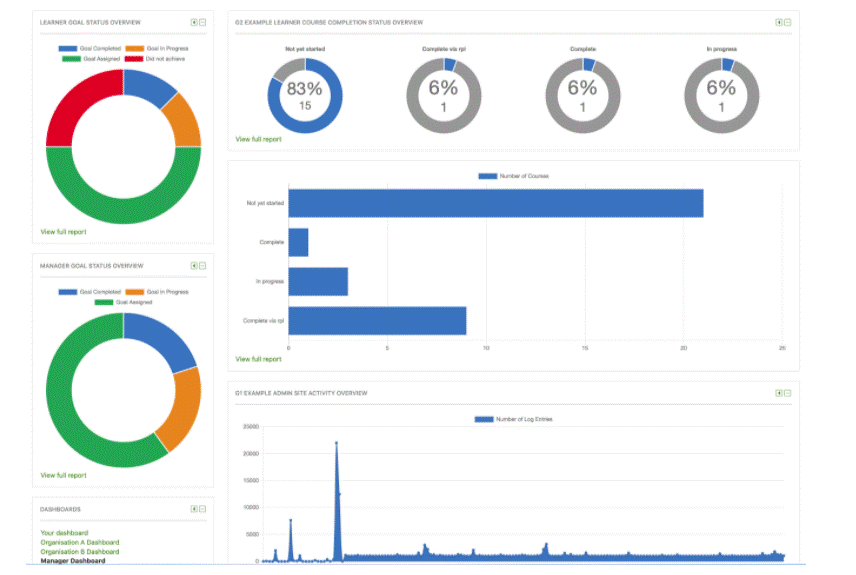
Once configured, dashboards make life easier for both learners, admins and stakeholders. They act as a central, personalized and customizable navigation area that greets users upon logging in.
Multiple dashboards can also be set to provide different users with different navigation options.
For example, you can create separate dashboards for the important roles in your system (such as learners, trainers, site administrators and stakeholders), providing easy access to important information and features.
Stakeholders will benefit from blocks showing completion rates or certifications for specific courses. Learners, on the other hand, will benefit from blocks showing their recent learning, course overviews and upcoming seminars.
Reporting features for today’s adaptable organizations
It’s a wrap! Prioritizing the essential enterprise LMS reporting features and tools above sets up your corporate training programs for success.
As we’ve observed with many of our customers, these features are transformational tools that enable large (and small) organizations to boost corporate training success, ensure compliance, effectively adapt to digitalization and manage employee performance.
If you’re still wondering what reporting features and tools you need, start internally. Speak to your stakeholders, instructors and system administrators. And don’t forget that while Totara Learn offers strong out-of-the-box reporting features, you can customize report templates and features to meet your precise needs—agility and adaptability are two other key benefits you enjoy with Totara products.
To learn more, contact our team. You can also view a comprehensive list of Totara Learn’s reporting features and tools.
Author bio: Hassan Uddeen is a freelance content strategist and SEO




